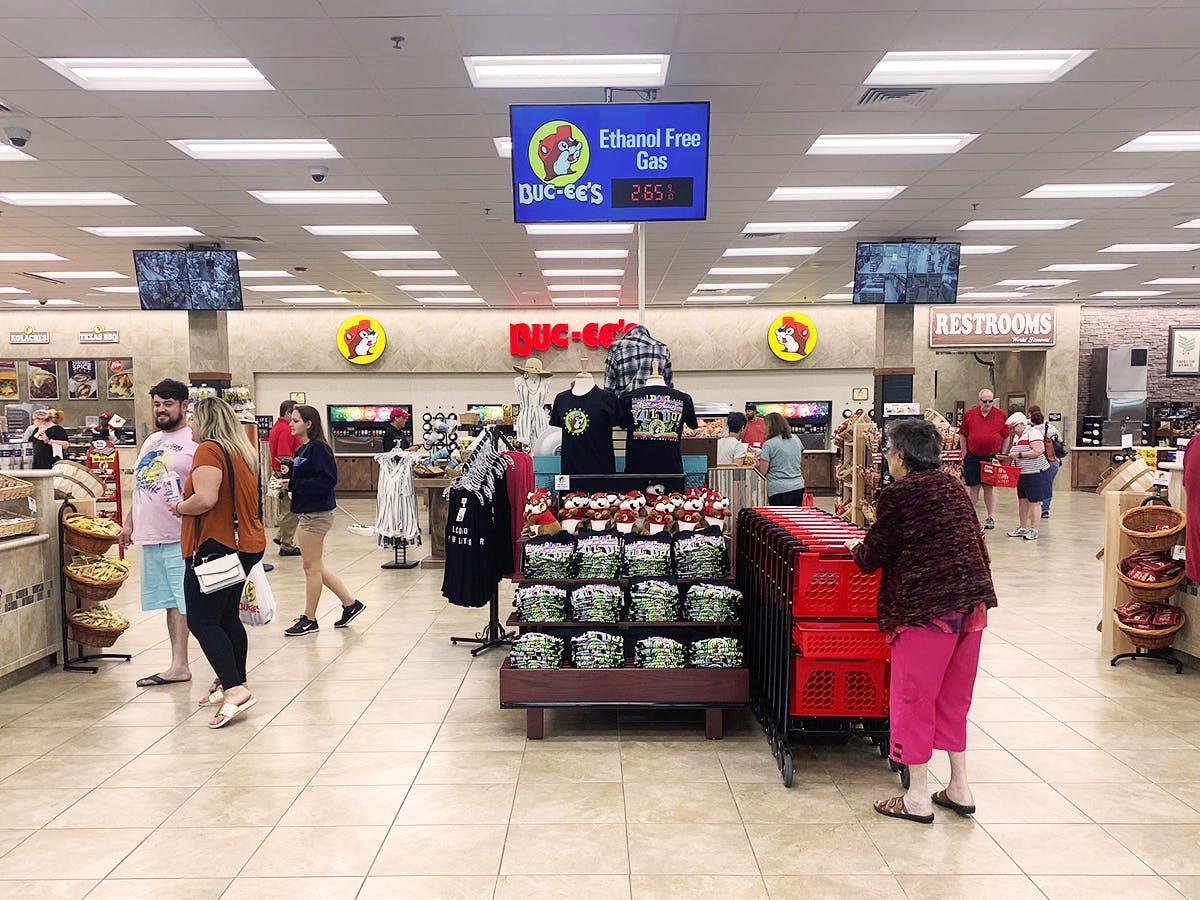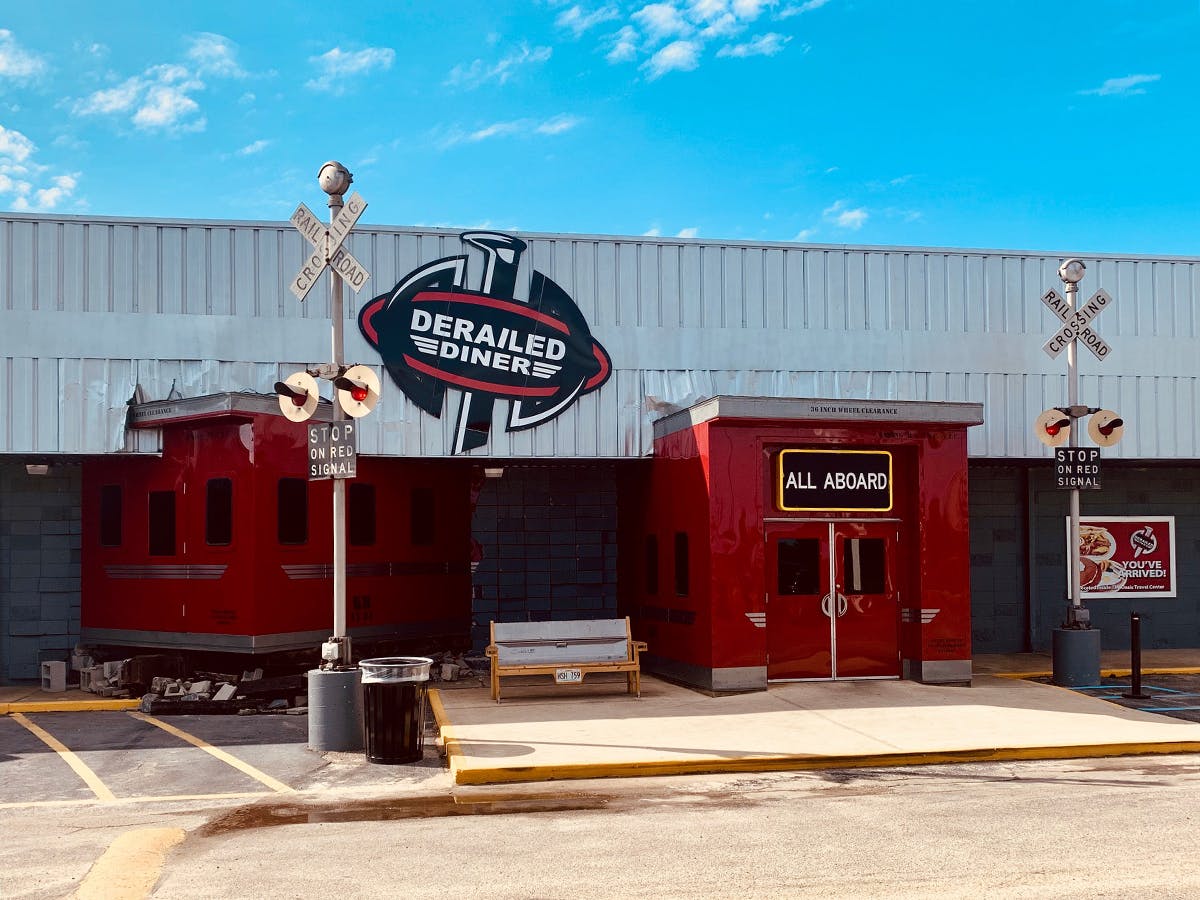As you approach from the west, from Mobile proper, on elevated highways crossing Louisiana-like swamps, you see the familiar, relentlessly cheery bucktoothed critter rising from the Alabama mire in all his cheekily worded billboard glory: “Beavers don’t drown,” he declares.
Before you know it, you’re there, easing into the parking lot of the first Buc-ee’s beyond Texas borders, 467 miles from its nearest sibling in Baytown. Your phone might tell you that you’re in the city of Robertsdale, but ever since late January this patch of swampland belongs to Loxley, Alabama (population 2,336).
I’m here to see how the latest Texas-born brand to make a national push is faring in joining the ranks of Whataburger, Whole Foods, Blue Bell, and Tito’s vodka. Is this a stepping-stone to what our own Eric Benson recently posited might be world domination, or will it prove to be a stumbling block, a rotten plank in the Beaver’s dam?
With me was Ferrill Gibbs, a Mobilian steeped in the gas station/convenience store trade. His late father twice built small networks of such oases along southern Alabama highways, once before retiring and selling out, and again after that retirement didn’t take.
One of the concerns Benson voiced was that so much of Buc-ee’s mystique up to this point has been steeped in Texana—especially the grab-and-go fare like jerky, jams, and pickled peppers. Would Alabamans, Floridians, and beach-bound travelers from elsewhere along the Interstate 10 corridor respond to the prospect of beef brisket sandwiches with the same Pavlovian drooling as Texans, or would they wonder instead where Buc-ee’s is hiding the country ham and biscuits? And what in blue blazes are “kolaches”? How do you even say that?
I don’t know exactly what I was expecting when I walked in. Maybe the scent of slow-smoking pork and an ocean of Crimson Tide and blue-and-orange Auburn University gear? Perhaps a statue (or at least a bust) of legendary Alabama coach Bear Bryant? What I discovered instead was a Buc-ee’s just like just about anywhere in Texas.
There are the joyful, peppy cashiers and the tobacco products to your left and right. A gust of sizzling sugar aroma from the confectionary, courtesy of the housemade fudge vats and reminiscent of those Sears-Roebuck candy counters of long ago, hits you like a warm Gulf breeze. Beef brisket sandwiches outnumber pulled pork at the Texas Round Up sandwich station. The bakery offers a full array of kolaches, both those properly known as such and the meat-filled ones. “That Guy” will tell you, pedantically if correctly, that “Actually, those aren’t kolaches. Those are klobásníky. And did you know the singular is kolač, not ‘kolache’?” (Don’t be That Guy.)
Gibbs was surprised at how small and marginalized the Roll Tide! / War Eagle! gift section was. It’s a mere flyspeck of an island in the Sea of Buc-ee, buried between the frozen foods and the beach gear. “In most places like this, it would be right by the door,” Gibbs says. “More front and center.”
But as I think back to my Texas Buc-ee’s visits, that marginalization seems par for the course. It’s not like you’re smacked in the face with the Aggie-Longhorn Cold War in the Luling or Wharton stores. While Texas college rivalries are fierce, every state takes a back seat to Alabama in that regard, so Gibbs believes downplaying that minefield is probably wise. As in Texas, better to sublimate all those vicious rivalries into Beaver worship. Each Tide or War Eagle T-shirt sold might mean Buc-ee’s merch left on the rack.

Aside from a couple shelves of craft brews, the college gear was about all I could find that was local to Alabama. Elsewhere were the same Texan jams, jerkies, pickles, and spice mixes; Californian and Australian wines; gleaming, Shangri-La restrooms; and folksy, slogan-bearing gifts found in any Buc-ee’s from Loxley to the chain’s westernmost outpost in New Braunfels, 663 miles toward the setting sun. (Gibbs took some jerky home to his wife, and the couple pronounced it about the best they’d ever had.)
I got talking to a quartet of ladies I found posing for a picture around the bronze Buc-ee outside near one of the entrances. They grew up together in Huntsville, Alabama. It was Sherry Hatchett, now a Nashville resident, who’d steered them to Buc-ee’s on their way to the beach. She’d been initiated by a cousin on a trip from Waco to San Antonio and was thrilled at the unexpected sight of the beaver in southern Alabama. Asked what she likes about the store, she said, “I guess that it’s just so . . . big!”
Its sheer size defies Buc-ee’s categorization as a convenience store, even if you can be in and out in a flash, just as you could at a 7-Eleven. (Theoretically. People tend to linger in Buc-ee’s, by choice rather than necessity.) Somehow the description “travel center” also doesn’t seem to cut it. I was once told that the secret of Buc-ee’s success was in “making truck stops feel safe for women and children.” Largely this was accomplished by going heavy on gift items fronted by a cartoon beaver, cleaning the bathrooms obsessively enough to pass muster as operating rooms in Level I trauma centers, and by banning semis and truckers from the premises.
Buc-ee’s Alabama beachhead hasn’t come without a hitch. As Benson reported, the company has been sued in federal court by Oasis Travel Center LLC, which alleges that the Loxley Buc-ee’s has employed predatory gas pricing in an effort to torpedo long-established businesses near one of the most lucrative crossroads in the state. The north-south Baldwin Beach Express is the primary conduit southbound from Interstate 10 to the towns along Alabama’s white sand beaches and crystalline waters.
That pricing battle is for the courts to decide, but a visit to the plaintiff’s place of business—the neighboring Oasis Travel Center—reveals that gas wars are the least of its problems. Like Buc-ee’s, it’s big and quirky, but that’s where the similarities end. Gibbs recalls a time when the Oasis ruled over this valuable crossroads and seemed like it would forever, but the day of our visit the parking lot is empty.
Oasis’s deliberate eccentricity is bizarre verging on sinister. The Derailed Diner—with a railway disaster theme—is a component of the little complex. Boxcars are built into the walls to resemble a train having jumped its tracks and crashed into the restaurant. There are working railway crossing signals flanking the front doors, with flashing red lights and an insistently clanging warning bell. The message, to me, is “Don’t come into this restaurant, or you will die.” Bored employees outnumber customers when I peek inside.

The ambience in the gift shop area is awful too. Fluorescent lighting makes everything appear dingy. The eighties hits on the sound system play at just the exact, wrong, sad volume to ruin any mood. There’s a roomful of Auburn-Bama gear, as opposed to the token assortment at Buc-ee’s. The food court is dominated by a Subway and a Chester Fried Chicken—yesterday’s sandwiches and downmarket yardbird. With its Day-Glo color scheme and black-and-white tiles, the slushee area looks like it was built in 1985 and has been unimproved since. There’s also a pirate ship and a replica hippy Volkswagen bus plopped down on the premises. It’s a pretty strange hodgepodge.
To get to the restrooms, you must walk down a warren of hallways plastered with road signs of every sort. The men’s room is clean enough, but I get lost trying to find my way the twenty feet back to the store. I get so confused by all the road signs on the walls, and whatever cutesy code those were trying to convey, that I keep ending up in storage rooms or supply closets or back where I started. Should I follow the “Exit Right Lane” sign or the one that says the “rest area” is to the left? Won’t that take me back to the men’s room?
Gibbs and I couldn’t leave that place fast enough. If you gave David Lynch free rein over a convenience store, this might be what he would come up with. Like Buc-ee’s, it aims to house many things under one roof, but unlike Buc-ee’s, all the seams are showing. It appears to be unraveling, at least judged by a customer count on one particular day in April.
Meanwhile, in these early days at least, Buc-ee’s shtick seems to be playing just fine outside Texas. A drive through the parking lot turned up only one Texas license plate amid row upon row of vehicles from Alabama, Florida, Mississippi, and Louisiana. We also found evidence of travelers heading for the Redneck Riviera from places like Tennessee, Kentucky, Ohio, Indiana, Michigan, and even a couple from Ontario. Gibbs told me his Facebook feed—mostly south Alabama locals—was studded with Buc-ee’s jubilation on the week of the grand opening of the 52,235-square-foot, 120-gas-pump location.
As for me, I still don’t know what to call Buc-ee’s. It’s a new kind of truck-free truck stop. It’s a enormous convenience store. It’s a travel center too. But when some combination of all of these things becomes a destination on its own, a place not to drop into but, as Hatchett put it to me, to be experienced, it’s something new. There might be no proper word for Buc-ee’s now. Buc-ee’s is less any sort of retail establishment than it is a realm.
- More About:
- Business







